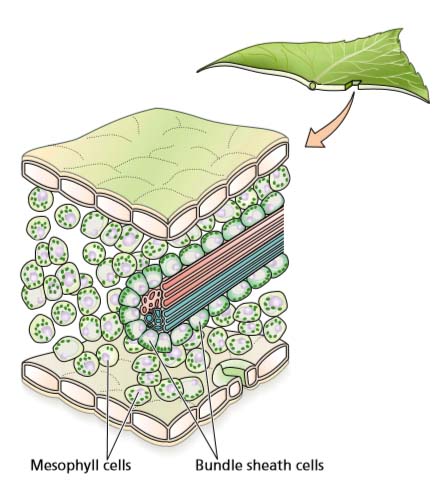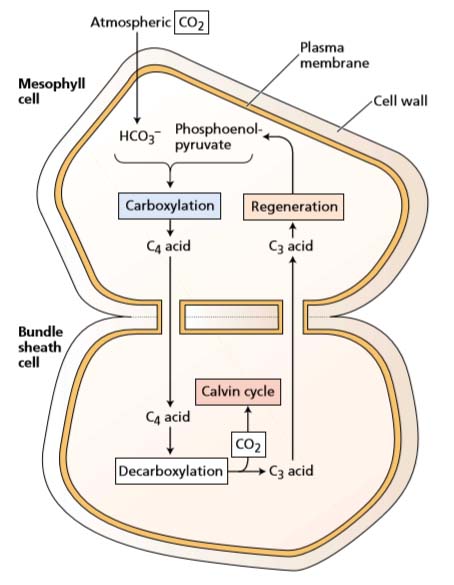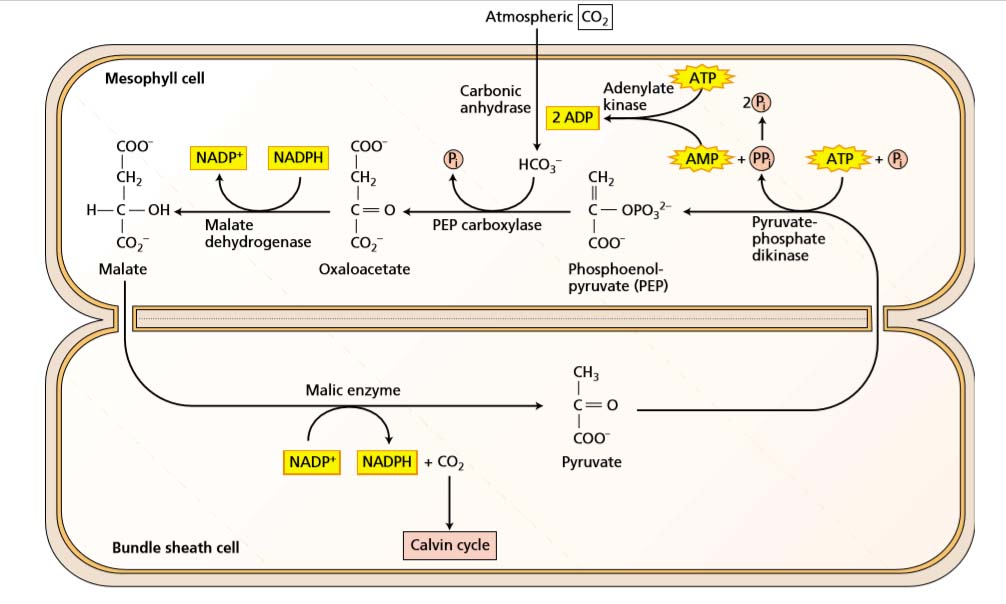All plants do not follow the same Calvin cycle (C-3 pathway) in which first stable product of carbon fixation is PGA (3-C compound). In some plants the first stable product of carbon fixation is four carbon compound (malate). These plants are called C4 plants.
C3 cycle and C4 cycles are running at a time but in different locations
C-3 Cycle in bundle sheath cells while C-4 Cycle in Mesophyll cells
Kranz anatomy
There are differences in leaf anatomy between plants that have a C4 carbon cycle (called C4 plants) and those that photosynthesize solely via the Calvin photosynthetic cycle (C3 plants). Across section of a typical C3 leaf reveals one major cell type that has chloroplasts, the mesophyll. In contrast, a typical C4 leaf has two distinct chloroplast-containing cell types: mesophyll and bundle sheath(or Kranz, German for “wreath”) cells.

Discovery
In pursuing these initial observations, M. D. Hatch and C. R. Slack elucidated what is now known as the C4 photosynthetic carbon cycle (C4 cycle) (Figure 8.10). They established that the C4 acids malate and aspartate are the first stable, detectable intermediates of photosynthesis in leaves of sugarcane and that carbon atom 4 of malate subsequently becomes carbon atom 1 of 3-phosphoglycerate (Hatch and Slack 1966). The primary carboxylation in these leaves is catalyzed not by rubisco, but by PEP(phosphoenylpyruvate) carboxylase
The C4 Cycle Concentrates CO2 in Bundle Sheath Cells
The basic C4 cycle consists of four stages:
1. Fixation of CO2 by the carboxylation of phosphoenolpyruvate in the mesophyll cells to form a C4 acid (malate and/or aspartate)
2. Transport of the C4 acids to the bundle sheath cells
3. Decarboxylation of the C4 acids within the bundle sheath cells and generation of CO2, which is then reduced to carbohydrate via the Calvin cycle.
4. Transport of the C3 acid (pyruvate or alanine) that is formed by the decarboxylation step back to the mesophyll cell and regeneration of the CO2 acceptor phosphoenolpyruvate


Importance of C-4 Cycle
In Hot,Dry Climates,the C4 Cycle Reduces Photorespiration and Water Loss.
Two features of the C4 cycle in C4 plants overcome the deleterious effects of higher temperature on photosynthesis that were noted earlier. First, the affinity of PEPcarboxylase for its substrate, HCO3–, is sufficiently high that the enzyme is saturated by HCO3– in equlibrium with air levels of CO2. Furthermore, because the substrate is HCO3–, oxygen is not a competitor in the reaction. This high activity of PEPcarboxylase enables C4 plants to reduce the stomatal aperture and thereby conserve water while fixing CO2 at rates equal to or greater than those of C3 plants. The second beneficial feature is the suppression of photorespiration resulting from the concentration of CO2 in bundle sheath cells